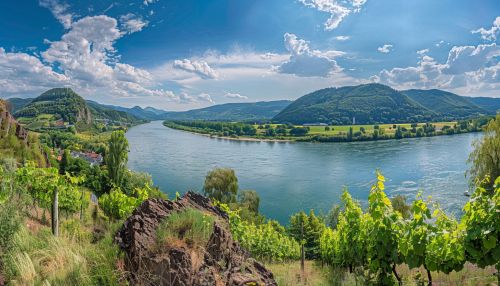Rhine
Geography
The Rhine is one of the major rivers of Europe, originating in the Swiss canton of Graubünden in the southeastern Swiss Alps, and flowing in a mostly northerly direction through Germany and the Netherlands, emptying into the North Sea. The river begins in the Swiss Alps, and flows through a series of deep valleys, gorges, and broad plains, shaping the landscapes of the countries it traverses.


The Rhine is divided into several sections: the Alpine Rhine, the High Rhine, the Upper Rhine, the Middle Rhine, the Lower Rhine, and the Delta Rhine. Each section has its own unique geographical characteristics and ecosystems, contributing to the river's rich biodiversity and making it a vital waterway for the regions it flows through.
History
The Rhine has played a significant role in shaping the history of Europe. From the Roman Empire, which used the river as a natural border, to the Holy Roman Empire, where it served as a central artery for trade and transportation, the Rhine has been at the center of many historical events and developments. It has been a source of inspiration for countless works of literature, art, and music, and has been the setting for many myths and legends, such as the famous Lorelei rock and the tale of the Nibelungen.
Economy
The Rhine is a major economic asset for the countries it flows through. It is one of the world's busiest waterways, supporting a vast network of inland navigation. The river is a crucial transport route for commodities such as coal, iron ore, and agricultural products, connecting industrial heartlands with major seaports. The Rhine is also a significant source of hydroelectric power, with numerous power plants located along its course. In addition, the river's picturesque landscapes attract millions of tourists each year, contributing to the local economies.
Ecology
The Rhine is home to a diverse range of flora and fauna. Its ecosystems range from alpine habitats in the Swiss Alps to lowland river habitats in the Netherlands. The river supports numerous species of fish, birds, mammals, and plants, some of which are endemic to the Rhine basin. However, the river's ecology has been significantly impacted by human activities, such as pollution, dam construction, and river regulation, leading to the loss of biodiversity in some areas. Efforts are being made to restore the river's ecosystems and protect its biodiversity through various conservation initiatives.
Culture
The Rhine has a rich cultural heritage, with a wealth of myths, legends, and folklore associated with it. It has inspired countless works of literature, art, music, and film, and is the setting for many popular festivals and events, such as the Rhine in Flames fireworks displays and the numerous wine festivals held in the vineyards along its banks. The river is also home to many historic sites and landmarks, including castles, cathedrals, and ancient ruins, which attract tourists from around the world.
